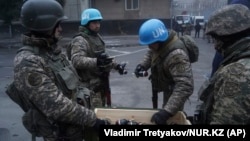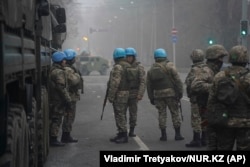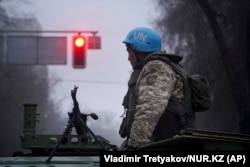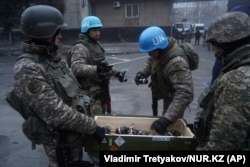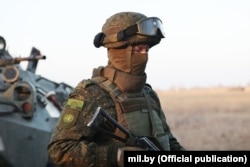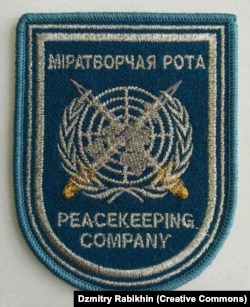Surprising photos of soldiers in Almaty wearing UN peacekeeping helmets spark a response from the United Nations.
Images released by the Associated Press on January 8 show several soldiers in Kazakhstan's largest city, Almaty, wearing helmets with "UN" stenciled on them in the unmistakable colors of United Nations peacekeeping forces. The photos, made by photographer Vladimir Tretyakov and shared by independent journalist Jake Hanrahan, have added to questions over what exactly is happening in the restive Central Asian country.
Since protests set off by gas prices broke out across Kazakhstan last week, Internet blackouts, unidentified gunmen, disputed official claims, and winter fog have made events on the ground increasingly murky.
A UN peacekeeping spokesperson on January 10 confirmed to RFE/RL by e-mail that the armed men seen in the images shared by AP were not part of a UN peacekeeping mission, saying, "We have conveyed our concern to the Permanent Mission of Kazakhstan on this issue."
The spokesperson wrote that "United Nations troop and police contributing countries are to use the UN insignia only when they are performing their mandated tasks as UN peacekeepers, in the context of their deployment within a United Nations peacekeeping operation as mandated by the UN Security Council."
Kazakhstan's military does have a United Nations-backed unit of English-speaking peacekeepers known as KAZBAT who are authorized to wear blue UN helmets, but only while on parade or during a UN peacekeeping mission.
A spokesman for Kazakhstan's Department of Defense in Almaty responded to a telephone query about the UN helmets on January 10.
First the man identified the blue-helmeted soldiers as being part of the UN-linked KAZBAT battalion, before saying they were not part of any UN mission and had a mission of "guarding strategic objects, airports, and governmental buildings."
He then said: "You may have seen online that KAZBAT has been to Libya. It's our peacekeeping corps," before adding: "you can also look up the Indian peacekeeping forces. Half of KAZBAT is now in Libya with [the Indian forces], the other half is here [in Kazakhstan]."
Kazakh forces joined an Indian battalion for a peacekeeping mission in Lebanon in 2018 and the two countries' peacekeeping forces are closely linked.
Eric David, an expert in international humanitarian law and peacekeeping operations at the Free University Of Brussels, says the Almaty images appear to capture "a gross misuse by the authorities of the troops who wore these helmets."
David told RFE/RL that if those behind the use of the blue helmets are Kazakh officials, "they trigger the international responsibility of Kazakhstan for an internationally wrongful act."
Any unauthorized use of United Nations uniforms that results in death or serious injury constitutes a war crime in international conflicts.
But David says despite the presence of foreign troops in the country, the current violence in Kazakhstan will almost certainly be classed as an internal, rather than international conflict by the International Committee of the Red Cross. David believes therefore, that use of the blue helmets in Kazakhstan is "unlawful, but not a war crime."
The expert in international law says he doesn't have the "slightest idea" why the helmets may have been used in Almaty but that it's possible that a massive call-up from the military may have resulted in a shortage of hardware, or it could be a deliberate attempt "to give the impression that real UN troops are with the Kazakh government."
Adding to the questions over the blue helmets in Almaty, photos and video appeared on Belarusian state media on January 9 showing Belarusian troops sporting arm badges that some have claimed to be muted United Nations insignias.
Belarus and other countries of the Russian-led CSTO military alliance sent contingents to Kazakhstan after President Qasym-Zhomart Toqaev requested the bloc's assistance in quelling the unrest in his country.
The insignia in fact belongs to Belarus's "Miratvorchaya Rota" and features the English translation "Peacekeeping Company" beneath an icon nearly identical to the United Nations' own design of the northern hemisphere flanked by wreaths representing peace. The Belarusian insignia has added crossed swords behind the hemisphere. The Belarusian peacekeeping unit has also served in Lebanon.
At the time of writing, a spokesperson for UN peacekeeping had not provided an answer to RFE/RL about what rules apply over the use of the United Nations' insignia in military uniforms.




